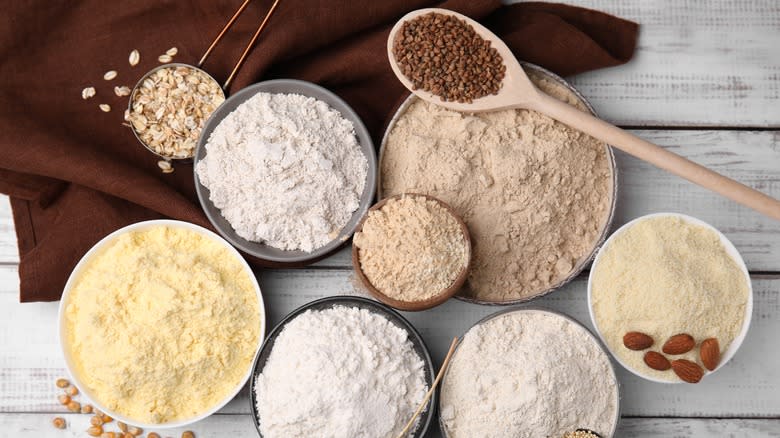
8 Types of Flour in India | Best Flour for Every Season
India’s culinary landscape is as diverse as its culture, and flour plays a starring role in kitchens across the country. From fluffy rotis to crispy dosas, the type of millets you choose can make or break a dish. But with so many options, how do you know which one is best, especially when the seasons change?
In this blog, we’ll dive into the most popular types of flour in India, their unique qualities, and which ones shine in summer and winter. Plus, we’ll share tips on incorporating these into your daily cooking for wholesome, seasonal meals.

India’s flours varieties reflect its agricultural richness and regional preferences. Here are the most commonly used flours and their culinary uses:
- Wheat (Atta)
– What is it? Whole wheat flour, ground from hard or soft wheat, is the backbone of Indian flatbreads like chapati, roti, and paratha.
– Characteristics: Nutty flavour, high fibre, and rich in nutrients like iron and magnesium.
– Uses: Ideal for daily staples like rotis, pooris, and naan. It’s versatile for both savory and sweet dishes like halwa.
– Regional Note: In North India, atta is a household essential, often freshly milled for maximum flavor.
- Maida (Refined Flour)
– What is it? Finely milled wheat flour stripped of bran and germ, resulting in a white, smooth texture.
– Characteristics: Low in fibre and nutrients but prized for its soft, elastic texture.
– Uses: Perfect for indulgent treats like naan, pastries, cakes, and samosa coverings. It’s a go-to for festive recipes.
– Regional Note: Widely used in urban bakeries and for dishes like Kerala’s parotta.
- Rice Flour
– What is it? Ground from polished or parboiled rice, this gluten-free, is a staple in South India.
– Characteristics: Light, fine texture with a neutral flavor.
– Uses: Essential for dosas, idlis, appams, and snacks like murukku. It’s also used for thickening gravies.
– Regional Note: Dominant in South Indian and coastal cuisines, especially in Tamil Nadu and Karnataka.
- Besan (Gram Flour)
– What is it? Made from ground chickpeas, besan is a protein-packed and gluten-free.
– Characteristics: Earthy, slightly nutty flavor with a dense texture.
– Uses: Used in fritters (pakoras), pancakes (chilla), and sweets like ladoos and mysore pak. It’s also a key ingredient in dhokla.
– Regional Note: Popular in Gujarat, Rajasthan, and North India for savory snacks.
- Ragi (Finger Millet Flour)
– What is it? A nutrient-dense millet made from finger millet, known for its cooling properties.
– Characteristics: Rich in calcium, iron, and fiber with a mildly sweet, earthy taste.
– Uses: Used for rotis, dosas, porridge, and baked goods. It’s a favorite in health-conscious diets.
– Regional Note: A staple in Karnataka, Tamil Nadu, and Andhra Pradesh.
- Jowar (Sorghum Flour)
– What is it? A gluten-free flour from sorghum grains, known for its hearty texture.
– Characteristics: High in protein and antioxidants, with a slightly sweet flavor.
– Uses: Ideal for bhakri, rotis, and porridge. It’s a great alternative for gluten-sensitive diets.
– Regional Note: Widely used in Maharashtra, Gujarat, and parts of South India.
- Bajra (Pearl Millet Flour)
– What is it? Made from pearl millet, this is a winter favorite in North India.
– Characteristics: Warm, nutty flavor with high iron and fiber content.
– Uses: Perfect for bajra rotis, khichdi, and snacks like thepla.
– Regional Note: A staple in Rajasthan, Gujarat, and Haryana during colder months.
- Corn/Makki ka Atta
– What is it? Ground from dried corn, this is distinct from cornstarch (used as a thickener).
– Characteristics: Gritty texture with a sweet, earthy flavor.
– Uses: Famous for makki ki roti, often paired with sarson ka saag in Punjab.
– Regional Note: A winter favorite in North India, especially Punjab and Haryana.
What is the difference between Flour and Millet?
The term flour is generally refer to finely ground cereal grain something that is granular in texture while Millet is a specific type of grain that is small but rich in nutrients with zero gluten seed. Both millets and grains are staple foods with high nutritional importance in various forms of diets, but millets have complex carbohydrates and are gluten-free.
Choosing the Right Flour for Seasonal Changes
India’s climate varies dramatically between summer and winter, and traditional wisdom suggests aligning your diet with the seasons for better health. Here’s a breakdown of the best flours for each season:
Summer: Cooling and Light Flours
Summer calls for flours that are easy to digest and have cooling properties to balance the body’s heat. Opt for:
– Ragi: Known for its cooling effect, ragi is perfect for summer porridges, dosas, or rotis. Its high calcium content supports bone health, and its low glycemic index keeps you full without spiking blood sugar.
– Rice: Light and gluten-free, rice flour is ideal for summer dishes like dosas, idlis, or steamed snacks. It’s gentle on the stomach and pairs well with cooling chutneys.
– Jowar: Another cooling millet, jowar is great for light rotis or porridge. Its high fiber content aids digestion, making it a smart summer choice.
Tip: Combine ragi or jowar with hydrating ingredients like buttermilk or coconut water for refreshing summer meals.
Winter: Warming and Hearty Flours
Winter demands flours that provide warmth and energy to combat the cold. Reach for:
– Bajra: Bajra is considered warming in Ayurveda, making it ideal for winter rotis and khichdi. Its high iron content boosts energy levels, perfect for chilly days.
– Makki ka Atta: Corn flour’s hearty texture and warming properties make it a winter staple. Makki ki roti with sarson ka saag is a classic for a reason—it’s comforting and nutrient-dense.
– Besan: Gram flour’s protein-rich profile and warming nature make it great for winter snacks like pakoras or chilla. It’s also versatile for sweets like besan ladoos.
Tip: Pair bajra or makki rotis with ghee and jaggery for an extra dose of warmth and flavor in winter.
Why Seasonal Flours Matter?
Choosing flours based on the season isn’t just about tradition—it’s rooted in science. Cooling millets like ragi and jowar help regulate body temperature in summer, while warming millets like bajra and makki provide sustained energy in winter. Plus, many of these millets are packed with nutrients that support immunity, digestion, and overall well-being. By incorporating a variety of millets into your diet, you can enjoy both flavor and health benefits year-round.
How to Incorporate Flours into Your Daily Routine
– Breakfast: Start your day with ragi porridge or besan chilla for a nutrient-packed meal.
– Lunch/Dinner: Swap white rice with jowar or bajra rotis for a fibre boost. Pair with seasonal veggies and dal.
– Snacks: Whip up rice flour murukku or besan pakoras for a crunchy treat.
– Desserts: Experiment with maida for cakes or besan for ladoos to satisfy your sweet tooth.
To truly master the art of cooking, consider enrolling in a culinary arts program. Learning from experts will help you understand the nuances of it, from kneading the perfect dough to creating restaurant-quality dishes at home.

Enroll in a Culinary Arts Program Today!
Ready to elevate your cooking game and make it a seamless part of your daily routine? Enroll in a culinary arts program to master the techniques, flavors, and creativity behind Indian cuisine. Whether you’re a beginner or a seasoned home cook, professional training will unlock new ways to incorporate seasonal flours into your meals. Visit www.nfcihospitality.com to explore courses and start your culinary journey today!
By embracing India’s diverse cuisine and aligning them with the seasons, you’ll not only enhance your meals but also nourish your body. Happy cooking!





